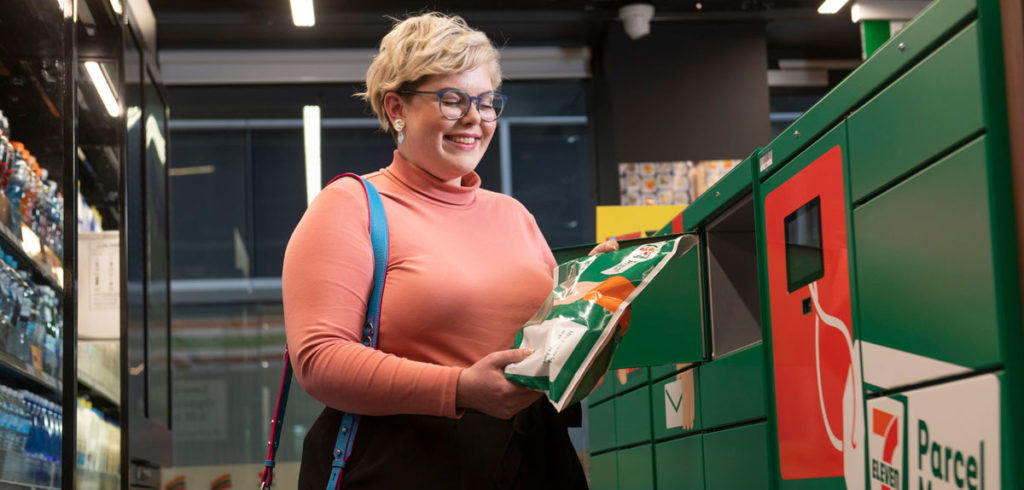7-Eleven’s growing parcel locker network could rival Australia Post’s network. So how is 7-Eleven doing it? Analysis from Marek Różycki, Last Mile Experts
Australia Post’s position as the nation’s leading parcel locker network is under threat from convenience store chain 7-Eleven.
7-Eleven is rolling out a new parcel locker network under its ParcelMate brand. It’s a carrier-neutral service, with lockers in 280 sites.
The ParcelMate service is an inbound and outbound parcels service for consumers. Flat rate parcels can be lodged at 7-Eleven stores for delivery via Toll.
The parcel locker network started with a trial at 20 sites in 2018. The lockers are located inside the 7-Eleven stores, giving 24-hour access.
The technology platform has been developed in partnership with HUBBED and Swipbox. HUBBED is a carrier-agnostic PUDO network.
“By investing in developing our own platform, we have the option to work with any delivery partners we choose for parcel pickups,” said 7-Eleven head of innovation, strategy and business development Stephen Eyears. 7-Eleven is currently working with Toll, DHL and Couriers Please.
By the end of 2019, 7-Eleven ParcelMate lockers will be available in approximately 400 7-Eleven stores nationwide. 7-Eleven has over 690 stores across Australia, compared to Australia Post’s network of over 3,500 post offices. 7-Eleven is part of the HUBBED network, which has over 1,800 locations. HUBBED already works with a range of carriers, including DHL, UPS and Couriers Please, with more being onboarded over time.
“The agnostic PUDO solution is the right approach in our view both for carriers with improved efficiency and consumers with greater control through choice and convenience,” said HUBBED founder and CEO David McLean.
In-store set-up
Inside the store, 7-Eleven has sacrificed retail space for the parcel lockers and prepaid satchels. Can parcel drop-off and collection services make up for the lost profit from FMCG lines? Or is this move also about foot traffic?
Newspapers and magazines don’t drive customer foot traffic like they used to, which has seen 7-Eleven switch its focus to other lines such as fresh coffee, ATMs and money transfer services. So adding parcel services in-store could help attract customers. A recent report from the UK showed that offering in-store carrier-neutral parcel collections can attract as much as 25% new customers. Moreover, up to 75% of customers collecting parcels are likely to buy something when at the store.
7-Eleven has done well to restrict the prepaid satchel range to domestic deliveries. Domestic parcels are simpler and don’t require customs declarations. Furthermore, domestic shipments can be a ‘self-serve’ option in-store, not requiring personal assistance from a staff member.
Carrier-neutral
What is important here is that 7-Eleven is taking the carrier neutral route, in contrast with Australia Post’s closed network. The carrier neutral approach will make it easier for the non-postal challenger to gain volumes and expand the network faster, potentially via partnerships.
Case studies have shown that this approach helps build parcel volumes (and therefore locker occupancy) quickly. While many posts, such as Australia Post, have built carrier-specific parcel locker networks, PostNord is setting up a carrier-agnostic network in Denmark.
Building a dense network quickly isn’t as easy as it seems, but the rewards are significant. And, of course, building a dense, carrier-agnostic network means beating Amazon to the punch! (Amazon’s new Australian parcel locker network is a topic for a future column.)
The competition
Australia Post has a growing network of carrier-specific parcel lockers. Couriers Please (part-owned by Singapore Post) has a modest network of POPStations but they can also leverage the HUBBED network.
There are also growing numbers of residential parcel lockers, and lockers on university campuses.
Conclusion
E-commerce last-mile demands out-of-home (locker and PUDO) options and it is clear that the key players on the Australian market have understood this. Now, it will be a question of how any alliances play out and who will be the ultimate winner…other than the customer, that is.


